From March 4 to March 11, 2022, the “Two Sessions” were held in Beijing. The Two Sessions are the annual meetings of the two main political bodies of the People’s Republic of China: the National People’s Congress (NPC), and the Chinese People’s Political Consultative Conference (CPPCC).
The Two Sessions provide a good indication of China’s heading and priorities in relation to its economy, diplomacy, society, trade, climate and environment.

In summary, the Two Sessions re-emphasized China’s priority of economic stability and focused less on climate action. This has been an ongoing theme for several years – I had written about this priority on economic growth for example after the Two Sessions in 2020 in the business newspaper Caixin and after the publication of the 14th Five-Year Plan in 2021.
What was surprising for this year’s outcomes is the (possibly over-) ambitious GDP growth target of 5.5% in 2022, which will require much government financing, possibly in infrastructure with negative consequences for environment.
Furthermore, China somewhat relaxed its climate ambitions with a more floating energy intensity target set for the whole period of the five-year plan, as compared to an annual energy intensity target.
The elephant in the room that did not see much public recognition was the war in Ukraine and its potential impacts on China and on the Belt and Road Initiative.
In this article, we present and analyze some of the main outcomes of the meetings related to:
- Economy
- Climate
- Biodiversity
- Green finance
- Belt and Road Initiative

1. Economy – “stable” growth at 5.5%
According to the Work Report delivered by China’s Premier Li Keqiang, China’s economy in 2021 grew by 8.1% (beating most expectations). Ensuring economic stability will be the “top priority” for the government in 2022, according to the Government’s Work Report.
For 2022, China aims to grow its economy by 5.5%.
This will require substantial government spending, and strong efforts to boost the struggling private sector.
Government spending growing. Financing China’s GDP growth will strongly rely on fiscal spending. While the deficit rate is said to be limited at 2.8% of GDP, the central government’s expenditure will increase by 3.9%. The central government plans to increase transfer payments to local governments by 18% to RMB 9.8 trillion (about USD 1.5 trillion). In addition, about RMB 3.65 trillion (about USD 600 billion) of special bonds will be arranged for local governments – the same amount as in 2021 and equivalent to 3% of China’s 2021 GDP (as a comparison, the EU’s Next Generation recovery plan was valued at EUR 750 billion over several years). The use of these funds has not been clearly laid out: they will “support ongoing projects, begin construction on major projects and new types of infrastructure”.
Support for small businesses. Tax and fee reductions, for example VAT exemptions or reduction in corporate income taxes, worth more than RMB 7.6 trillion (about USD 1.1 trillion) were promised in order to support manufacturing, small and low-profit enterprises and self-employed businesses, provide cash flow support to enterprises and promote consumption and investment.
Energy – “establish the new before abolishing the old”. After energy outages in 2021 (mostly due to high coal-prices and under-utilization of existing coal-fired power plants, rather than due to lacking capacity), China “will step up petroleum, natural gas and mineral exploration and development”, upgrade coal-fired power plants (i.e., “make them cleaner”), and provide “preferential policies on electricity use for industries which are experiencing particular difficulties”. The liberalization of the electricity market, which is a foundational building block of the green energy transition, was not strongly featured.
Finance – “lower interest rates”. The Government Work Report emphasized that financial institutions should lower real loan interest rates, cut fees and provide financing for small and micro-enterprises (albeit acknowledging that there is work to do for financial institutions to provide such loans due to lack of collaterals of many of those enterprises)
Innovation and investment: The government proposed to increase the proportion of R&D expenses for science and technology-based small and medium enterprises and to focus fiscal efforts on investment in energy, transport and urban infrastructure upgrades. The proposed infrastructure spending includes key water conservancy projects, transportation networks, energy facilities, pipeline networks renovation, and flood control and drainage facilities.
Agriculture – boost production in “all around rural revitalization”. A big push in the 2022 work plan is the focus on agricultural production. As a reaction to disrupted supply chains or possibly with the goal gain strategic independence of agricultural imports, China will expand land use for agricultural production, fertilizer provision, mechanisation of agriculture, the seed industry, and acquatic production of proteins.
| Our take: China’s goals remain consistent to previous years and – at least in terms of economic growth – ambitious. However, in regard to green growth, China’s envisaged economic path is less conducive for global climate and environmental goals: with a highly volatile global economy, China’s growth will have to be driven by continued government spending, which traditionally has gone into infrastructure projects with negative consequences for climate emissions (e.g., through energy-intensive steel, concrete) and biodiversity. The emphasis on coal is a step sideways at best, with most economies trying to accelerate the reduction of fossil fuels for electricity. The emphasis on agricultural production is understandable from a strategic independence goal, but the risk is that further expanding intensive agriculture may have negative consequences on the use of land, fertilizers and water. |

2. Climate protection
Climate protection in the form of China’s “dual carbon goals” (namely, reaching its carbon emission peak before 2030 and become carbon neutral by 2060) was generally re-affirmed during the meetings. Importantly, Li Keqiang highlighted China’s ambition to transition from relative emission targets (such as emissions per unit of GDP) to absolute emission targets.
Yet, with the first goal-post of the dual carbon goals in the year 2030 being 8 years away, China’s emphasis was to ensure energy security “based on our resource endowment” – which is coal, with the mantra of “establishing the new before abolishing the old”. Within these boundaries, the government proposed measures to improve energy efficiency, including those of coal-fired power plants, while at the same time promoting renewable energy. This included ambitions to:
- Strengthen the clean and efficient utilization of coal, while taking also into account energy security concerns;
- Promote large-scale wind and photovoltaic bases;
- Improve the power’s grid ability to absorb renewable energy power generation;
- Promote R&D related to green and low-carbon technologies;
- Promote energy conservation and carbon reduction in energy-intensive industries (e.g. steel, nonferrous metals, petrochemicals, and construction);
- Curb the development of high-energy consumption and high-emissions projects; and
- Improve incentives and restraint policies for pollution and carbon reduction.
Officials highlighted that a combination of short-terms and long-term policies should be used to promote the green and low-carbon transformation of the economy and that three points are crucial:
- Ensure the safety of carbon reduction;
- Support the transformation of highly-polluting industries; and
- Actively identify and respond to climate risks.
Regarding this last point, Zhou Jianmin, a member of the CPPCC National Committee and Vice Chairman of the CPPCC of Jiangsu Province, considers that two major issued must be addressed: the lack of understanding of concepts and methods related to climate and environmental risk management, and the existing barriers to its practical application.
The government also emphasized the importance of international cooperation, as well as the of integrating domestic and international sustainable development policies and standards.
| Our take: Within the English version of the Government Work Report 2022, coal development was featured strongly (mentioned 12 times), while renewable energies were only mentioned 6 times. At the same time, the re-affirmation of the goal to move from relative to absolute emission targets is important. However, considering the goal to be more flexible in regard to set energy intensity goals to compensate for economic uncertainties, it is likely that for the next months energy use will be liberalized with negative consequences in terms of air pollution and climate emissions. |

3. Biodiversity
The Two Sessions highlighted the importance of biodiversity conservation as a prerequisite for the harmonious coexistence of man and nature.
The Central Committee for Democratic progress suggested to:
- Formulate national strategies for coordinating climate change and biodiversity protection, as the two topics are closely linked;
- Integrate spatial land use control with the “dual carbon” objective;
- Formulate a mixed land use policy conducive to the large-scale development of renewable energy;
- Give more ecological space for the future development of new energy, the protection of biodiversity and the enhancement of the carbon sink and adaptation capacity of ecosystems;
- Promote the conservation, development and use of biomass energy; and
- Strengthen research on the synergistic effects of ecosystem restoration on climate change and biodiversity conservation.
A particular focus in the work plan and the budget plan for ecosystem protection is the restoration of the Yangtze River basin.
The budget plan allocates RMB 99.2 billion (about USD 16 billion) for key ecosystem service zones and RMB 17 billion for “special funds for ecological protection”. Furthermore, the Kunming Biodiversity fund will be set up.
| Our take: While China is still scheduled to host the biodiversity COP in Kunming in 2022 (it has been repeatedly postponed since 2020), biodiversity conservation could be expected to play a larger role in China’s ambitions. China has taken some steps to provide funding and capacity for ecosystem restoration, and to build a national park system. While the overall funding for biodiversity conservation seems limited and the legal system for biodiversity conservation could be strengthened, it is promising to see China’s growth of funding and ambition for biodiversity protection. |

4. Green finance
China’s green transition is inextricably linked to green finance. According to Wu Gang, a member of the National Committee of the CPPCC and Chairman of Xinjiang Goldwind Science & Technology, the green finance industry has been highly valued by the government, which provides important financial support for the development of the renewable energy industry and supports steps towards the “dual carbon” target. It is estimated that RMB 3-4 trillion of green investment is needed annually to achieve the country’s carbon peak by 2030 and the carbon neutrality target by 2060.
China’s green finance development continues to accelerate (in January 2022 the number of green bonds issued was four times that of the same period in 2021).
At the same time, delegates highlighted their ambitions for further developing China’s green financial system. According to the Research Bureau of the Central Bank, to Li Minbin, a member of the National Committee of the CPPCC and co-CEO of the Bank of East Asia and to external observers, and to Hu Xiaolian, a member of the Standing Committee of the CPPCC and Chairman of the Export-Import Bank of China, China’s green financial system should strengthen its work in terms of:
- Defining clear and unified green finance standards;
- Improving the mechanism to make green finance more popular;
- Encouraging innovation and arousing financial markets interest in green products;
- Improving the information disclosure and supervision mechanism of green projects;
- Developing the carbon financial market;
- Studying how to integrate the national carbon trading market with the international market;
- Supporting energy and transport projects along the Belt and Road Initiative;
- Improving risk prevention and control; and
- Deepening cooperation to make green finance a global chorus.
Discussions during the Two Sessions emphasized the importance of unifying green finance standards, as the coexistence of different standards (both locals and international) makes it more complex to protect the rights and interests of market participants. Currently various standards coexist in China, for instance green credit standards issued by the China Banking and Insurance Regulatory Commission, different green bond standards issued by the People’s Bank of China, the National Development and Reform Commission and the China Securities Regulatory Commission, and green standards set by local governments.
| Our take: China’s green finance development is promising: it is encouraging to see strong analyses on the need for future harmonization with international standards, which should lead to further work with the International Platform for Sustainable Finance (IPSF) under the leadership of China and the European Union, and within the G20 Sustainable Finance Working Group. However, challenges within China remain, particularly considering that too many regulators provide guidances that might lead to confusion, while technical capacity to actually implement environmental, social and governance (ESG) risk management and disclosure still needs to be improved in many financial institutions. |

5. Belt and Road Initiative (BRI) – de-risking and greening
Investments in the Belt and Road Initiative did not play a central role in the Government Work Report, as only one paragraph highlights China’s ambition to promote high-quality cooperation while “effectively guarding against overseas risks”.
However, international trade, including within the BRI, was more heavily featured: Li Keqiang emphasized the construction of new land and sea corridors in the West and to expand the coverage of export credit insurance for small and medium-sized foreign trade enterprises.
The BRI was given prominence on other days: for instance, Wang Yi, China’s Foreign Minister, Wang Yiming, Professor at the School of International Relations and Director of the Institute of International Affairs at Renmin University of China, and Zhan Chunxin, a member of the National Committee of the CPPCC, highlighted how, despite the impact of COVID-19, the Belt and Road Initiative has “maintained a good momentum” through trade and the completion of projects, such as the China-Laos railway or the new port of Haifa in Israel.
With China’s announcement in September 2021 to not build new coal-fired power plants overseas, Hu Xiaolian, a member of the Standing Committee of the National Committee of the CPPCC and Chairwoman of the Export-Import Bank of China (Exim Bank), said in an interview that the Exim Bank would no longer provide financing support for new overseas coal power projects. But, Exim Bank would provide financing for completed overseas coal power projects, if these projects had energy-saving and carbon-reducing technology transformation and upgrading needs.
Hu Xiaolian further emphasized that the Exim Bank would increase its support for green projects such as clean energy and ecological protection, and would pay more attention to the construction of “small and beautiful” projects that benefit people’s livelihood.
Hu Sishe, a member of the Standing Committee of the CPPCC proposed three directions to strengthen international cooperation along the BRI: sub-national cooperation, exchanges and cooperation through cultural brands (especially between China and Europe), and cooperation with non-governmental friendship organization.
Zhang Shuibo, a member of the National Committee of the CPPCC, Vice Chairman of the Tianjin Municipal Committee of the Democratic Progressive Party and Professor of the Department of Management and Economics of Tianjin University, pointed out that the conflict between Russia and Ukraine will have an impact on the Belt and Road Initiative in terms of security of overseas investments, and recommended to focus on the safe management of complex political economic and social challenges and to enforce a high-quality development strategy.
| Our take: As we had shown in our 2021 BRI Investment report, China’s engagement in the BRI through construction and investment has been stable at a low level. A big factor has been COVID-19 which has increased both sovereign credit risks (as many BRI projects traditionally rely on local government guarantees) and shifted demand. Focusing on trade rather than investment and construction in the BRI seems to align with China’s overall goals of its dual circulation strategy. It is furthermore promising to see China’s Exim Bank explicitly supporting the green ambitions of the BRI. |






Comments are closed.